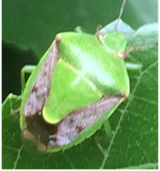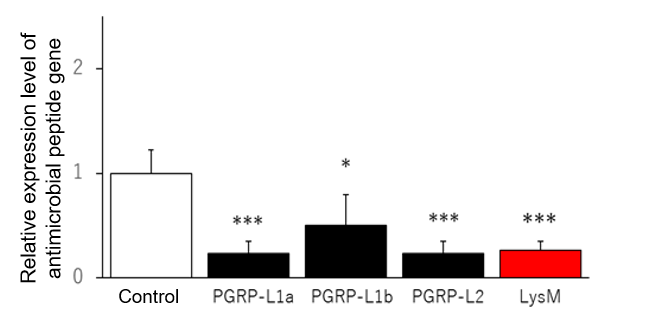The Institute of Agrobiological Sciences, NARO (NIAS) has clarified a part of a new immunity mechanism in insects, which has not been identified before, using brown-winged green stink bug,Plautia stali. Generally, the immune system of insects starts functioning with the invasion of microorganism into the body. It has been clarified for the first time that the hemipteran stinkbug has a unique microbial recognition protein. This result may lead towards the development of new pest control technology exclusive for hemipterans.
Overview
Many organisms including insects have the ability to quickly recognize the invasion by foreign substances such as bacteria and to protect themselves by quickly eliminating them by means of an immunity mechanism. Several proteins related to the recognition of bacteria were known already from previous studies using Drosophila and other insects. Using brown-winged green stink bug, P. stali, it has been clarified for the first time that a protein containing the lysin motif (LysM) domain can recognize bacteria and activate an immune response.
The LysM has not been found from insects other than hemipterans. Therefore, by means of targeting LysM, it is possible to develop pest control technology exclusive for hemipterans without any harmful effects on other useful insects.
Publication
Nishide Y, Kageyama D, Yokoi K, Jouraku A, Tanaka H, Futahashi R, Fukatsu T (2019) Functional crosstalk across IMD and Toll pathways: insight into the evolution of incomplete immune cascades. Proceedings of the Royal Society B Biological Scienceshttps:doi.org/10.1098/rspb.2018.2207
For Inquiries
Contact: http://www.naro.go.jp/english/inquiry/index.html
Reference Information

Plautia stali

Expression level of the antimicrobial peptide gene when suppressing the
function of various peptidoglycan-recognizing proteins
When suppressing the action of already known PGRP, the expression level of antimicrobial peptide gene responsible for insect immunity decreased. Similarly, when suppressing the action of LysM, the expression level of the antimicrobial peptide gene decreased. (* Indicates statistically significant decrease in expression levels) (modified by Nishide et al. 2019).




